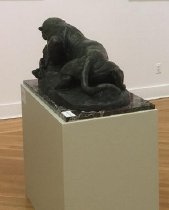Object Record
Images




Metadata
Catalog number |
61.10 |
Artist |
Barye, Antoine-Louis |
Title |
Crouching Jaguar Devouring a Hare on a Rocky Base (Jaguar prenant un lievre) |
Date |
Early 20th Century |
Object Name |
Sculpture |
Description |
Antoine-Louis Barye (1796-1875) was an innovator who popularized sculptures of animals in many phases of their lives. He set in motion a school of sculptors known as the "animaliers." His knowledge of animals and the way he proportioned their bodily structures give his works great vitality and force. Authentic "Barye Bronzes" are superb renderings, showing the unobstructed powers of animals, their emotions and a breadth-of-life quality. This bronze sculpture is characteristic of Barye's work, and its greenish casting that makes a dull sound when tapped is due to the special alloy of copper and lead. There are no die-stamp numbers on the base, so it is impossible to know the number of this casting, and documentary evidence in the foundry of Susse Freres indicates that after 1847 a die-mark was not applied on every work. The cire perdue method, also known as the lost-wax process, was not employed by most foundries during the nineteenth century. Because a die-stamp is lacking on the outer surface of this version of the Crouching Jaguar, and it is presently impossible to examine the interior, the exact technique of casting cannont be ascertained. If the interior is sandy, this Jaguar has been sand cast; if the inside is smooth, it has been cast by the lost-wax method, which offers a more faithful reproduction of the original sculpture, requires little finishing or chiseling, and the results are considered to be far above those obtained by the sand process. Perhaps, we may accept as true what is inscribed in the sculpture about the technique of casting. It may have been done during Batye's lifetime, since Susse Freres acquired the edition rights of Bayer's works at an early date. If this version was not cast in 1847 -1876, it can be dated in the early twentieth century. Research paper by Caryl Rubenfield (1978); this extract by Arlene Tannenbaum (1979). |
Medium/Material |
Cast bronze |
Dimensions |
H-40 W-36 L-102 cm |
Year Range from |
1800 |
Year Range to |
1875 |
Exhibition and Publication History |
*"Queens College Art Collection," First Supplement, 1961, p. 5, #365. * "Art from the Queens College Art Collection, Part I" City Art and Culture Center, NY 1973, p.14, #53 * "A Selection From the Queens College Art Collection" , Klapper, 1979, #35 *"Joseph Ternbach: Collector, Connoisseur," Queens College, Mattis Gallery, 1984, p. 53 # 79, ill. Irene Winter, Curator. * Exhibited The Queens Museum, "The Artists Managerie: Five Milleniums of Animals in Art," NY 1974, #75, ill. * Exhibited"Director's Choice, Part II," G-TM, 10/10-12/20/02. A. Winter, Curator. *"Director's Choice, Part II," G-TM, Fall 2002, Amy Winter *Exhibited in 'Hope is the Thing with Feathers: Art of the Natural World', 4/11-7/31/2019. *Exhibited at 'THE GIFT: Queens College Collects', Feb 23 - May 25,2023. Exploring the Language of Form: October 17, 2024 – May 1, 2025, Godwin-Ternbach Museum |
Culture |
French |

